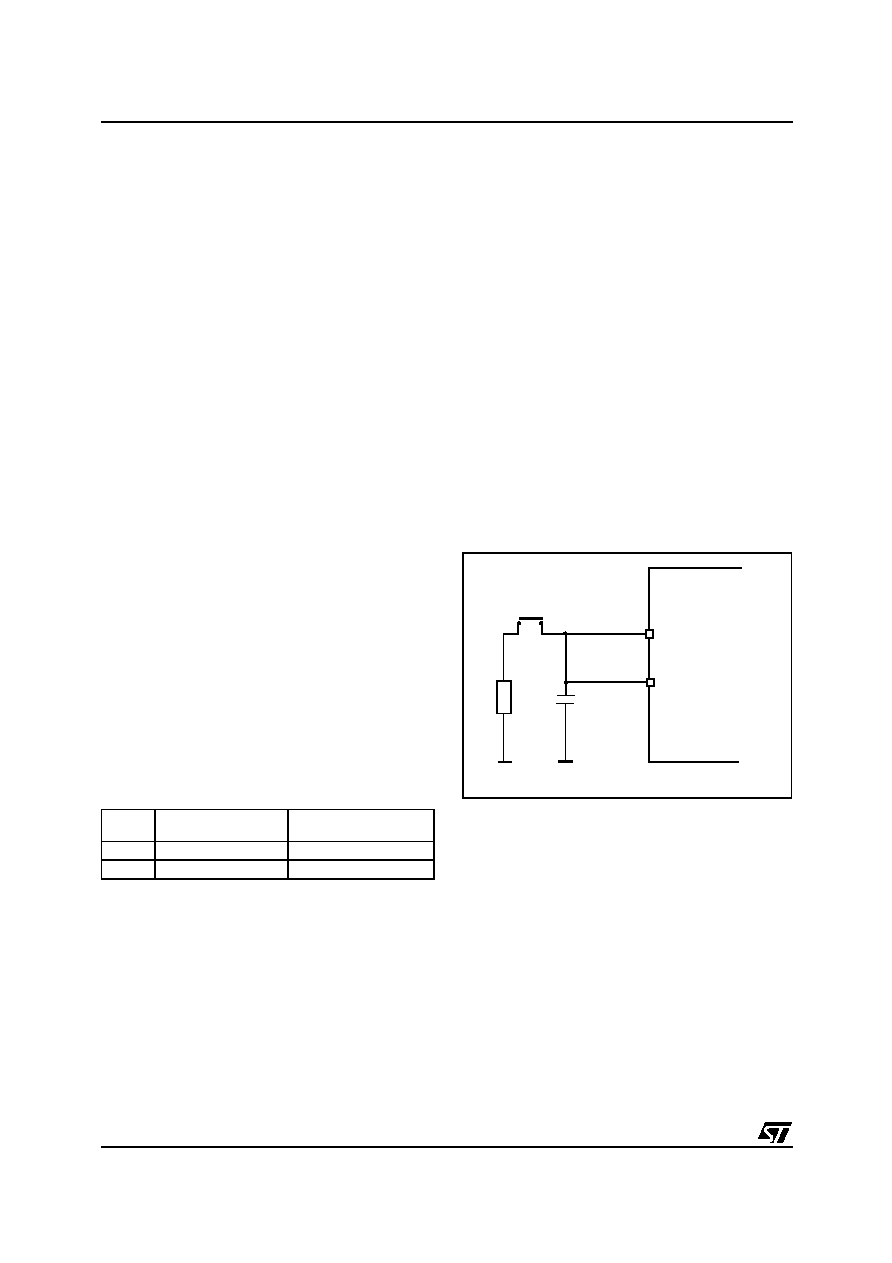- 您現(xiàn)在的位置:買賣IC網(wǎng) > PDF目錄98144 > ST62T03CM6E (STMICROELECTRONICS) 8-BIT, OTPROM, 8 MHz, MICROCONTROLLER, PDSO16 PDF資料下載
參數(shù)資料
| 型號(hào): | ST62T03CM6E |
| 廠商: | STMICROELECTRONICS |
| 元件分類: | 微控制器/微處理器 |
| 英文描述: | 8-BIT, OTPROM, 8 MHz, MICROCONTROLLER, PDSO16 |
| 封裝: | 0.300 INCH, LEAD FREE, PLASTIC, SOP-16 |
| 文件頁數(shù): | 38/100頁 |
| 文件大小: | 1440K |
| 代理商: | ST62T03CM6E |
第1頁第2頁第3頁第4頁第5頁第6頁第7頁第8頁第9頁第10頁第11頁第12頁第13頁第14頁第15頁第16頁第17頁第18頁第19頁第20頁第21頁第22頁第23頁第24頁第25頁第26頁第27頁第28頁第29頁第30頁第31頁第32頁第33頁第34頁第35頁第36頁第37頁當(dāng)前第38頁第39頁第40頁第41頁第42頁第43頁第44頁第45頁第46頁第47頁第48頁第49頁第50頁第51頁第52頁第53頁第54頁第55頁第56頁第57頁第58頁第59頁第60頁第61頁第62頁第63頁第64頁第65頁第66頁第67頁第68頁第69頁第70頁第71頁第72頁第73頁第74頁第75頁第76頁第77頁第78頁第79頁第80頁第81頁第82頁第83頁第84頁第85頁第86頁第87頁第88頁第89頁第90頁第91頁第92頁第93頁第94頁第95頁第96頁第97頁第98頁第99頁第100頁

ST6200C/ST6201C/ST6203C
42/100
WATCHDOG TIMER (Cont’d)
9.1.3 Functional Description
The watchdog activation is selected through an
option in the option bytes:
– HARDWARE Watchdog option
After reset, the watchdog is permanently active,
the C bit in the WDGR is forced high and the user
can not change it. However, this bit can be read
equally as 0 or 1.
– SOFTWARE Watchdog option
After reset, the watchdog is deactivated. The func-
tion is activated by setting C bit in the WDGR reg-
ister. Once activated, it cannot be deactivated.
The counter value stored in the WDGR register
(bits SR:T0), is decremented every 3072 clock cy-
cles. The length of the timeout period can be pro-
grammed by the user in 64 steps of 3072 clock cy-
cles.
If the watchdog is activated (by setting the C bit)
and when the SR bit is cleared, the watchdog initi-
ates a reset cycle pulling the reset pin low for typi-
cally 500ns.
The application program must write in the WDGR
register at regular intervals during normal opera-
tion to prevent an MCU reset. The value to be
stored in the WDGR register must be between
FEh and 02h (see Table 11). To run the watchdog
function the following conditions must be true:
– The C bit is set (watchdog activated)
– The SR bit is set to prevent generating an imme-
diate reset
– The T[5:0] bits contain the number of decre-
ments which represent the time delay before the
watchdog produces a reset.
Table 11. Watchdog Timing (fOSC = 8 MHz)
9.1.3.1 Software Reset
The SR bit can be used to generate a software re-
set by clearing the SR bit while the C bit is set.
9.1.4 Recommendations
1. The Watchdog plays an important supporting
role in the high noise immunity of ST62xx devices,
and should be used wherever possible. Watchdog
related options should be selected on the basis of
a trade-off between application security and STOP
mode availability (refer to the description of the
WDACT and EXTCNTL bits on the Option Bytes).
When STOP mode is not required, hardware acti-
vation without EXTERNAL STOP MODE CON-
TROL should be preferred, as it provides maxi-
mum security, especially during power-on.
When STOP mode is required, hardware activa-
tion and EXTERNAL STOP MODE CONTROL
should be chosen. NMI should be high by default,
to allow STOP mode to be entered when the MCU
is idle.
The NMI pin can be connected to an I/O line (see
Figure 26) to allow its state to be controlled by soft-
ware. The I/O line can then be used to keep NMI
low while Watchdog protection is required, or to
avoid noise or key bounce. When no more
processing is required, the I/O line is released and
the device placed in STOP mode for lowest power
consumption.
Figure 26. A typical circuit making use of the
EXERNAL STOP MODE CONTROL feature
2. When software activation is selected (WDACT
bit in Option byte) and the Watchdog is not activat-
ed, the downcounter may be used as a simple 7-
bit timer (remember that the bits are in reverse or-
der).
The software activation option should be chosen
only when the Watchdog counter is to be used as
a timer. To ensure the Watchdog has not been un-
expectedly activated, the following instructions
should be executed:
jrr 0, WDGR, #+3 ; If C=0,jump to next
ldi WDGR, 0FDH
; SR=0 -> reset
next :
WDGR Register
initial value
WDG timeout period
(ms)
Max.
FEh
24.576
Min.
02h
0.384
NMI
SWITCH
I/O
VR02002
1
相關(guān)PDF資料 |
PDF描述 |
|---|---|
| ST62T10BM6 | 8-BIT, OTPROM, 8 MHz, MICROCONTROLLER, PDSO20 |
| ST62T25BB6 | 8-BIT, OTPROM, 8 MHz, MICROCONTROLLER, PDIP28 |
| ST62T20BB6 | 8-BIT, OTPROM, 8 MHz, MICROCONTROLLER, PDIP20 |
| ST62T18CB6 | 8-BIT, OTPROM, 8 MHz, MICROCONTROLLER, PDIP20 |
| ST62T18CM3 | 8-BIT, OTPROM, 8 MHz, MICROCONTROLLER, PDSO20 |
相關(guān)代理商/技術(shù)參數(shù) |
參數(shù)描述 |
|---|---|
| ST62T08CB6 | 功能描述:8位微控制器 -MCU OTP EPROM 1K SPI/UAR RoHS:否 制造商:Silicon Labs 核心:8051 處理器系列:C8051F39x 數(shù)據(jù)總線寬度:8 bit 最大時(shí)鐘頻率:50 MHz 程序存儲(chǔ)器大小:16 KB 數(shù)據(jù) RAM 大小:1 KB 片上 ADC:Yes 工作電源電壓:1.8 V to 3.6 V 工作溫度范圍:- 40 C to + 105 C 封裝 / 箱體:QFN-20 安裝風(fēng)格:SMD/SMT |
| ST62T08CB6 | 制造商:STMicroelectronics 功能描述:IC 8BIT MCU OTP 1K 62T08 DIP20 |
| ST62T08CM6 | 功能描述:8位微控制器 -MCU OTP EPROM 1K SPI/UAR RoHS:否 制造商:Silicon Labs 核心:8051 處理器系列:C8051F39x 數(shù)據(jù)總線寬度:8 bit 最大時(shí)鐘頻率:50 MHz 程序存儲(chǔ)器大小:16 KB 數(shù)據(jù) RAM 大小:1 KB 片上 ADC:Yes 工作電源電壓:1.8 V to 3.6 V 工作溫度范圍:- 40 C to + 105 C 封裝 / 箱體:QFN-20 安裝風(fēng)格:SMD/SMT |
| ST62T09CB6 | 功能描述:8位微控制器 -MCU OTP EPROM 1K No Intf RoHS:否 制造商:Silicon Labs 核心:8051 處理器系列:C8051F39x 數(shù)據(jù)總線寬度:8 bit 最大時(shí)鐘頻率:50 MHz 程序存儲(chǔ)器大小:16 KB 數(shù)據(jù) RAM 大小:1 KB 片上 ADC:Yes 工作電源電壓:1.8 V to 3.6 V 工作溫度范圍:- 40 C to + 105 C 封裝 / 箱體:QFN-20 安裝風(fēng)格:SMD/SMT |
| ST62T09CB6 | 制造商:STMicroelectronics 功能描述:IC 8BIT MCU OTP 2K 62T09 DIP20 |
發(fā)布緊急采購,3分鐘左右您將得到回復(fù)。